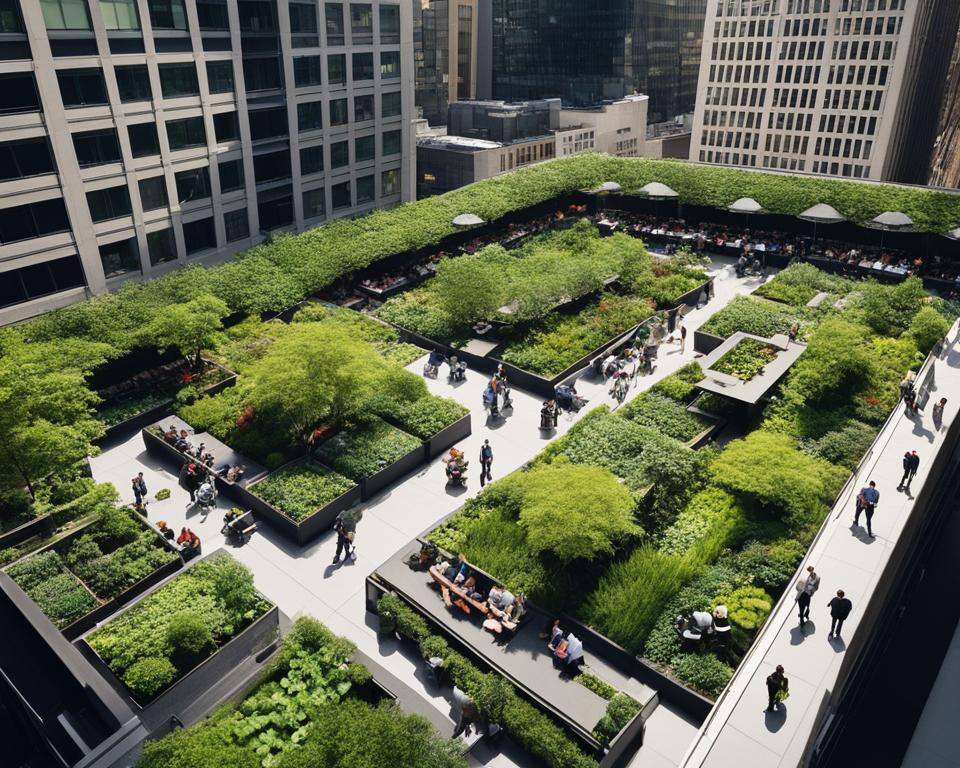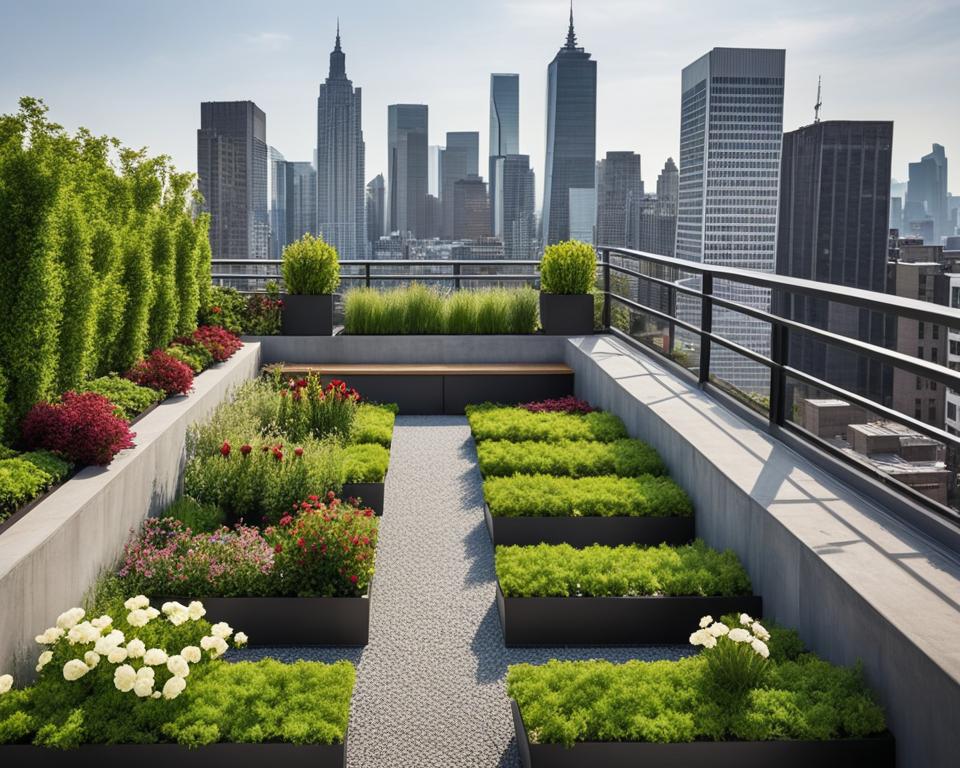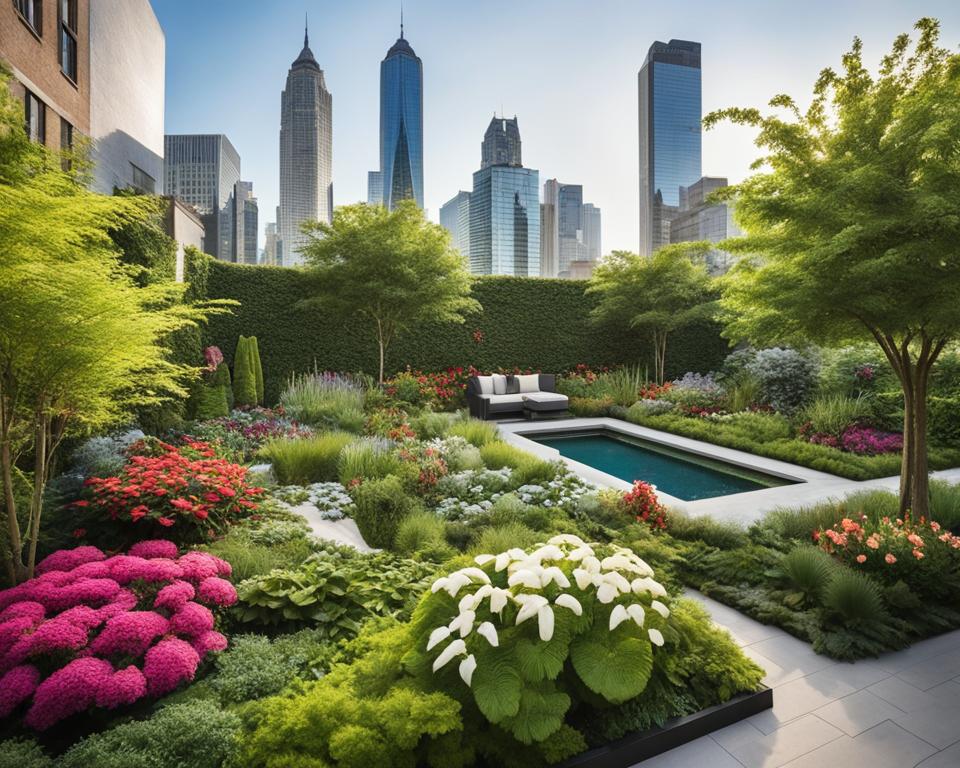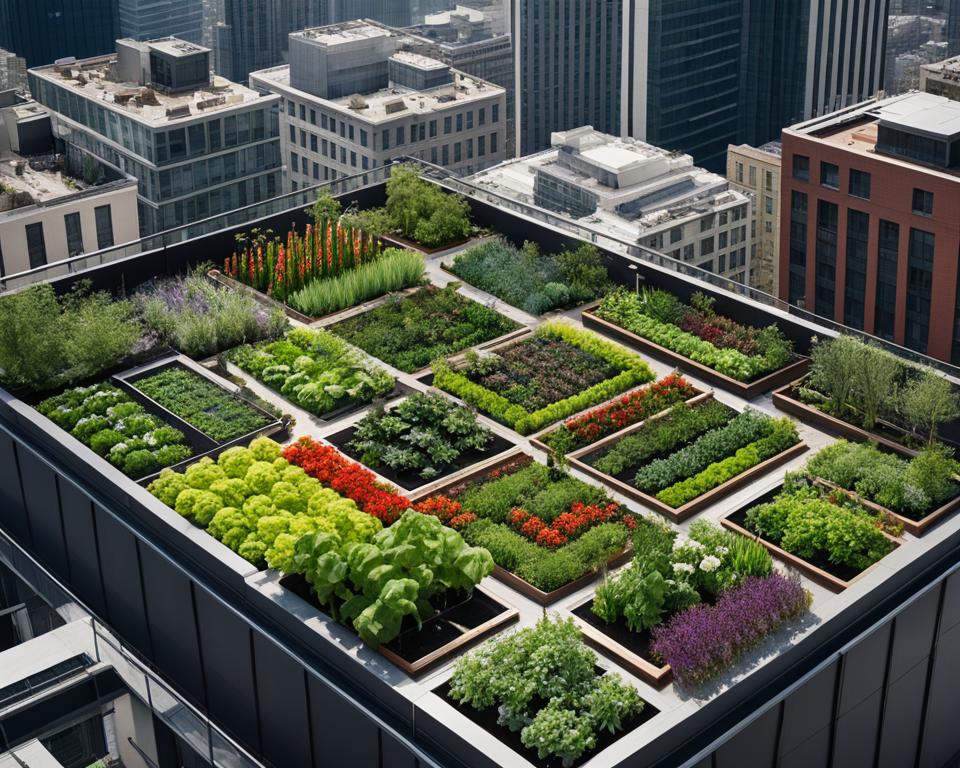
Imagine stepping out onto your own slice of paradise high above the city’s hustle and bustle, where lush greenery cascades around you against a backdrop of panoramic urban vistas. In the heart of the city, urban rooftop gardens are transforming homes and businesses alike, creating enchanting escapes that cater not just to the eye but also to the environment. Welcome to the world of green roofs, where such idyllic settings are not a far-fetched fantasy but an attainable reality.
Your urban dwelling can embody this tranquil essence with the right rooftop gardens installation, turning your very roof into an eco-friendly sanctuary. From sipping your morning brew amidst a garden to hosting starlit soirees surrounded by foliage, urban rooftop gardens weave together the serenity of nature and urban convenience seamlessly. These gardens aren’t just beautiful – they’re cleverly designed spaces of respite that are as functional as they are picturesque.
By cultivating such spaces, you’re not only crafting a personal retreat but also contributing to the ecological resilience of your city. Can you picture your very own urban rooftop garden? It might just be the next best step for you and your environment.
Key Takeaways
- Rooftop gardens transform city rooftops into vibrant, green sanctuaries.
- They offer environmental benefits like cooling buildings and cleansing the air.
- Utilising space efficiently, these gardens don’t compromise valuable urban land.
- Incorporating green roofs provides privacy, aesthetics, and a touch of nature’s bliss.
- From design to maintenance, there are specialist services to bring your rooftop garden to life.
Exploring the Core of Urban Rooftop Gardens
Transitioning to sustainable urban living, you might admire the bustling cityscape from ground level, yet it’s above, where tranquil green hideaways are shaping a revolution in contemporary ecological design. Urban rooftop gardens, synthesising serenity with eco-friendly principles, reflect a burgeoning interest in these alluring arenas of green amidst the concrete skylines.

The concept behind the green hideaways in the cityscape
Imagine a space just above the frantic urban hustle, where greenery softens the stark city edges and provides a pocket of peace. These sanctuaries, known for their myriad rooftop gardens benefits, are devised to tackle the scarcity of nature in metropolitan environments, offering not just a visual treat but also a psychological reprieve. The rooftop gardens become vital spaces for relaxation, reflection and reconnection with nature.
Historical evolution of rooftop gardens
The historical tapestry of rooftop gardens weaves back to the lush Hanging Gardens of Babylon, one of the Seven Wonders of the Ancient World. The modern resurgence in these elevated edens aligns with a growing environmental consciousness, aiming to counterbalance urban sprawl with verdant vibrancy. Today, the fusion of tradition and innovative design has resurrected these tranquil oases, colouring urban skylines with hues of sustainability and tranquillity.
A snapshot of rooftop gardens from across the world
Perched atop cities around the globe, these gardens manifest a diversity of rooftop gardens ideas, from the pragmatic to the picturesque. In the UK’s capital, rooftop spaces reveal thoughtfully curated ecosystems, while Austria and Switzerland present meticulous integration of green roofs into cultural heritage sites. Each garden is a testament to the ingenuity of landscape artisans, who embed photovoltaic systems and edible plantations within these lofty plots of land, showcasing innovative design solutions that merge aesthetics with ecological utility.
| Country | Notable Rooftop Garden | Features |
|---|---|---|
| United Kingdom | Queen Elizabeth Hall Roof Garden | Wildflower meadows, fruit trees, and vistas of London skyline |
| Austria | University of Vienna’s Science Rooftop Garden | Research space for urban ecology, community gardening |
| Switzerland | Zurich’s Sky Garden | Sustainable design with recreational and dining areas |
Unpacking the Multifaceted Benefits of Rooftop Gardens

The installation of urban rooftop gardens can be seen as an investment not only in your property but in the wellbeing of the entire urban environment. Let’s delve into the scope of rooftop gardens benefits that stem from these verdant retreats.
- Thermal Regulation: Rooftop gardens contribute significantly to cooling the urban landscape. The layers of soil and vegetation work as natural insulation, reducing the need for air conditioning in the summer and adding warmth during the winter.
- Enhanced Air Quality: By acting as a natural air filtration system, these gardens absorb pollutants and particulate matter, ensuring that you can breathe cleaner air each time you step out onto your rooftop haven.
- Acoustic Buffering: Amid the city’s bustle, your rooftop garden serves as a serene acoustic buffer. The substrate and plants absorb and reflect sound waves, creating a more peaceful atmosphere underneath.
- Stormwater Management: Green roofs can retain a significant amount of rainwater, thereby mitigating the impact on sewer systems during heavy downpours and lessening the likelihood of flooding and erosion.
In addition to these ecological benefits, the social and economic aspects cannot be overlooked.
Here’s a more detailed look at the economic and social benefits:
| Benefit | Description | Impact |
|---|---|---|
| Economic Savings | Reduced energy costs thanks to thermal regulation capabilities | Long-term savings on utility bills |
| Property Value Increase | Enhancement in aesthetic appeal and energy efficiency | Rise in property marketability and potential resale value |
| Community Engagement | Spaces for community gardens and social interaction | Strengthened neighbourhood ties and social cohesion |
| Health and Wellness | Access to peaceful green areas for relaxation and recreation | Improved mental health and physical wellbeing |
With the rise of urban rooftop gardens, you’re not just planting flora; you’re sowing the seeds for a healthier and more sustainable future. Your individual contribution to combating urban heat islands and creating a habitat for local wildlife is invaluable. Embrace these insights and consider the lasting impact a rooftop garden could have on your home and environment.
Creative Designs for Rooftop Gardens
As urban spaces become ever more precious, rooftop gardens design and landscaping offer an ingenious solution. These green escapes maximise the use of limited spaces, while also contributing positively to the urban ecosystem. Let’s delve into designing rooftop gardens that are not only a sight to behold but are also underpinned by sustainability.
Maximising Space in Compact Areas
One key factor in rooftop gardens landscaping is the creative optimisation of space. By utilising vertical gardening techniques and compact landscaping, every square inch of rooftop space can be transformed into a lush enclave. This approach allows you to enjoy a variety of plants and features, regardless of the rooftop size at your disposal.
Integrating Sustainable Practices in Rooftop Garden Design
Sustainable practice is at the core of modern rooftop gardens design. Eco-friendly materials, energy-efficient water systems, and native plant selections are amongst the myriad ways to ensure your garden contributes to environmental conservation. Combine these with innovative technologies like rainwater harvesting and you’ll have a rooftop garden that’s not just smart, but also sustainable.
Examples of Innovative Rooftop Gardens Designs
Across the world, the boundaries of what makes a rooftop garden have been stretched and redefined. From high-end commercial establishments to cosy residential blocks, here are some pioneering concepts:
- Container Gardening: Perfect for rotating seasonal plants and managing space efficiently.
- Solar-Paneled Pergolas: An elegant blend of technology and design, providing both shade and energy.
- Multi-Layered Landscapes: Creating varied heights and depths for a visually dynamic environment.

These examples not only showcase creative flair but also represent the essence of sustainability and functionality fused into the design of rooftop gardens. Your space could be next to undergo this transformative process, turning it into a captivating, vibrant oasis within the cityscape.
Rooftop Gardens: A Keystone in Urban Ecology

Have you ever imagined a bustling cityscape artfully intertwined with pockets of verdant tranquillity? Urban rooftop gardens are metamorphosing concrete jungles into ecologically vibrant oases. As keystones of urban ecology, their contribution extends far beyond mere aesthetics. They are a testament to the sustainable amalgamation of nature with urban sophistication.
Imagine green roofs providing a sanctuary for a plethora of species amidst skyscrapers. By fostering urban biodiversity, these gardens are crucial for insects, birds, and pollinators, crafting novel ecosystems on otherwise barren rooftops. The greenery of these elevated spaces delivers a cooling effect, significantly reducing the heat absorbed by buildings and consequently, lowering the reliance on air conditioning — a triumph in energy conservation.
- Contribution to stormwater management by absorbing rainfall
- Enhancement of air quality and reduction of urban heat islands
- Creation of habitats promoting urban biodiversity
But the significance of rooftop gardens landscaping goes even deeper. You own a powerful tool in combating the ecological challenges of urbanisation. From Vertical gardens scaling high rises to expansive green carpets embellishing shopping centres, these spaces do not merely exist; they thrive, evolve, and invigorate urban life.
Your role in this movement is critical. As city planners, architects, and residents advocate for greener infrastructure, you can join in building a future where every rooftop is an opportunity for ecological enrichment. Urban rooftop gardens are not just a feature; they are the cornerstones of a resilient, healthy, and sustainable urban environment.
The A-Z of Installing and Maintaining Rooftop Gardens
Delving into the realm of rooftop gardens, your journey begins with the essentials of rooftop gardens installation and transitions into seamless rooftop gardens maintenance. It’s a harmonious blend of horticulture and architecture, requiring precision for sustainable success. Allow us to guide you through the key stages that ensure your verdant retreat thrives throughout the changing seasons. From plant selections made for your local climate to strategic logistical planning, each step is a building block towards your personal sanctuary in the sky.
Selecting the Right Plants for Your Climate
First and foremost, choosing plants that suit your specific climate is paramount. The resilience of these species determines the longevity and vibrancy of your garden. Whilst you’re tempted by exotic flora, local varieties often prove hardier against the elements. It’s not just about aesthetics; it’s about sustainability. Assess the microclimate of your rooftop and consult with professionals like those at Rockstar Roofing to ensure your plant selection is apt for the conditions it will face.
Navigating the Logistical Challenges of Rooftop Gardening
Overcoming logistical hurdles is the next critical phase. From ensuring your roof can bear the weight of the soil to implementing efficient drainage systems, attention to detail is key. Roofing specialists are invaluable in this aspect, as they can provide bespoke solutions to substrate depths, waterproofing, and access for routine maintenance. Don’t let the complexity dissuade you; with the right expertise, these challenges are mere stepping stones to your lush urban retreat.
Sustaining Your Rooftop Garden Through the Seasons
Maintaining the vitality of your rooftop garden all year round involves embracing adaptive gardening practices. Drip irrigation systems conserve water and deliver it precisely where needed. Structural elements resistant to the whims of weather play their part in shielding your garden from harsh conditions. It’s a continuous journey of care and adjustment as seasons transform. For ongoing support, don’t hesitate to contact your local specialists at Rockstar Roofing; they’re ready to assist with each season’s unique demands and ensure that your rooftop garden remains an enchanting escape throughout the year.
FAQ
What exactly is a rooftop garden?
A rooftop garden, also known as a green roof, is an area of vegetation planted on the roof of a building. It is designed to create a tranquil green space in an urban environment, often incorporating various plants, shrubs, and even small trees to create a serene oasis amidst the concrete jungle.
Can you tell me more about the concept behind urban rooftop gardens?
The concept behind urban rooftop gardens is to utilise the unused space atop buildings to create peaceful, green hideaways that not only enhance the aesthetics of the urban landscape but also provide environmental benefits. They offer city dwellers a touch of nature while helping to combat urban issues like air pollution and the heat island effect.
How have rooftop gardens evolved over time?
Rooftop gardens date back to ancient civilisations, such as the Hanging Gardens of Babylon, and have evolved dramatically over the centuries. Modern rooftop gardens have become more sophisticated, incorporating sustainable practices and advanced architectural designs to create versatile green spaces that cater to ecological needs and urban lifestyles.
Could you provide some examples of rooftop gardens from around the world?
Sure, there are many exemplary rooftop gardens globally, such as the Kensington Roof Gardens in London, Sky Garden in Singapore, and the Brooklyn Grange in New York. Each showcases unique designs and uses, from lush entertainment spaces to urban farms that contribute to local food production.
What are some benefits of having a rooftop garden?
Rooftop gardens offer numerous benefits, including reducing urban heat island effect, improving air quality, providing habitats for wildlife, and enhancing mental well-being. They also help in managing stormwater, reducing noise pollution, and can improve the energy efficiency of buildings.
What are some creative design ideas for a rooftop garden in a compact area?
Creative designs for compact rooftop gardens might include vertical plantings, container gardens, or multi-functional furniture with built-in planting spaces. Utilising every square inch with smart, space-saving techniques ensures that even the smallest of roof spaces can transform into a verdant retreat.
How can sustainable practices be integrated into rooftop garden design?
Sustainable practices in rooftop garden design can include using drought-resistant plants, setting up rainwater harvesting systems, installing solar panels, and choosing recycled or eco-friendly materials for garden infrastructure.
Can you give me examples of innovative rooftop garden designs?
Examples of innovative rooftop garden designs may feature rooftop beehives, hydroponic systems, aeroponic gardens, or the integration of tech elements like smart irrigation systems that optimize water use. Designs often reflect a blend of functionality, aesthetic appeal, and ecological responsibility.
Why are rooftop gardens considered keystone features in urban ecology?
Rooftop gardens are considered keystone features in urban ecology because they create natural habitats within the city for a variety of species, help to cool the urban environment, and improve air quality. They act as a crucial link in the ecosystem, providing benefits that ripple across the urban landscape.
What should I consider when selecting plants for my rooftop garden?
When selecting plants for your rooftop garden, consider the climate of your area, the weight-bearing capacity of your roof, and the exposure to the elements such as sun, wind, and rain. It’s important to choose hardy species that can thrive with minimal maintenance and survive the unique conditions of a rooftop setting.
What are some of the logistical challenges of rooftop gardening?
Logistical challenges of rooftop gardening can include ensuring safe access for maintenance, creating adequate drainage systems, managing the additional weight of the garden, and protecting the roof membrane from damage. Balancing these factors is essential for the successful installation and longevity of a rooftop garden.
How can I sustain my rooftop garden throughout the changing seasons?
To sustain your rooftop garden throughout the seasons, implement a maintenance plan that accommodates the changing environmental conditions. This might involve seasonal planting, using protective coverings for plants during harsh weather, and adjusting watering and fertilising schedules as needed. Regular check-ups and upkeep will help your garden remain vibrant year-round.

Comments are closed